Gamry's eQCM 15M™ 即电化学石英晶体微天平( EQCM )基于快速阻抗扫描技术,可以与电化学测试同步进行。EQCM是研究界面过程最有价值的工具之一,腐蚀、离子嵌入、离子吸附、聚合物生长和传感器结合,都引起质量变化,这些质量变化可以通过监测振荡石英晶体的谐振频率来测量。
Menu
Close
石英晶体微天平
产品详细信息
eQCM 15M是通用型仪器,可以兼容1~15MHz范围内的晶片,可与不同类型QCM池或晶片夹具搭配使用。仪器具有高分辨率,可以检测ng / cm2 级别微小的质量变化,比材料单层的质量还轻!
Gamry尽可能提供初始实验所需的仪器、配件等全套相关资料,包括eQCM 15M电化学石英晶体微天平、5MHz镀金晶片(5片)、静态池、电缆连接线、操作说明与软件。
主要特征
- 兼容1-15MHz范围内的晶片• 兼容多种QCM池及晶片夹具
- 检测ng/cm2级别微小的质量变化
- USB接口
- 可与Gamry各个型号电化学工作站同步运行和采集数据
- 阻抗扫描的方式测量谐振频率,同时提供串联谐振频率ƒs和并联谐振频率ƒp
- 可使用灵活、定制化的Echem Analyst 2™软件进行数据查看与分析
应用
- 电活性聚合物
- Li+嵌入
- 腐蚀研究
- 电沉积
- 自组装单分子层
- 抗原抗体相互作用
- 表面活性剂吸附
- 蛋白质吸附
- 离子和溶剂传输
eQCM 15M在两个谐振频率附近快速扫描(参见 “石英晶体微天平原理 应用报告),该方法的优势在于不需要扣除寄生电容,仪器就可以维持振荡。此外,每次采集数据点时,都会显示相应的阻抗曲线,让用户能深入了解电极上气泡的形成,或识别池子装置的问题。有了这两个谐振频率,还可以初步定性了解耗散变化。当ƒs和ƒp响应相近,表明膜趋于刚性;而当ƒs和ƒp响应出现显著差异,则表明膜不是刚性。
eQCM15M可以手动调节晶片的驱动幅度,这对于测试离子液体(IL)或高阻尼粘性溶液尤为重要。对于负载大的晶片,手动提高驱动振幅的方式,与直接测试耗散或时间域测耗散相比,具有显著的优势。
数据分析在Gamry开发的Echem Analyst 2™软件中进行,该软件灵活方便,可根据需要定制显示曲线,绘制质量-时间曲线、质量-电荷曲线、质量-电位曲线,或者耗散-时间的基本关系曲线等。
晶片清洗
关于石英晶体微天平所用晶片的清洗问题,我们通常认为晶片是一次性使用的耗材,但如果需要清洗,食人鱼溶液(酸性溶液)是一个较好的选择。该溶液危险性较高,在处理此溶液时,请采取所有必要的预防措施。在使用前应该查看MSDS(化学品安全说明书) ,并进行适当的安全培训。
eQCM 15M在两个谐振频率附近快速扫描(参见“
参数
频率测量 |
|
| 频率范围 | 1– 15 MHz |
| 频率分辨率 | 0.02 Hz |
环境要求 |
|
| 工作温度范围 | 0 to 45°C |
| 相对湿度 | 低于90% (非冷凝) |
| 储存和运输温度 | -25 to 75°C |
| 最大运输加速度 | 30G |
常规信息 |
|
| 电源输入电压 | 10 - 14伏 |
| 电源功率 | 25 W |
| 尺寸 | 175 x 115 x 80 mm |
| 重量 | 1 kg |
| 外部电源适配器尺寸 | 120 x 55 x 30mm |
| 外接电源适配器重量 | 400 g |
电脑配置要求
- USB 2.0 或 USB C
- Microsoft® Windows™ 10/11





